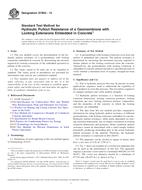Potrebujeme váš súhlas na využitie jednotlivých dát, aby sa vám okrem iného mohli ukazovať informácie týkajúce sa vašich záujmov. Súhlas udelíte kliknutím na tlačidlo „OK“.
ASTM D7853-13
Standard Test Method for Hydraulic Pullout Resistance of a Geomembrane with Locking Extensions Embedded in Concrete
Automaticky preložený názov:
Štandardná skúšobná metóda pre hydraulické vyťahovanie odpor Fólia s aretáciou rozšírenie nezabetonovaný
NORMA vydaná dňa 1.3.2013
Informácie o norme:
Označenie normy: ASTM D7853-13
Poznámka: NEPLATNÁ
Dátum vydania normy: 1.3.2013
Kód tovaru: NS-39190
Počet strán: 4
Približná hmotnosť: 12 g (0.03 libier)
Krajina: Americká technická norma
Kategória: Technické normy ASTM
Kategórie - podobné normy:
Anotácia textu normy ASTM D7853-13 :
Keywords:
concrete liners, concrete protection, geomembranes, liners, pullout resistance, studs, ICS Number Code 59.080.70 (Geotextiles), 91.080.40 (Concrete structures)
Doplňujúce informácie
| Significance and Use | ||||||||||||||
|
5.1 Due to hydraulic pressure that may be present on some applications, engineers need to understand the capability of these products to resist this pressure. This test allows engineers to compare products and verify pullout strength. 5.2 Hydraulic pullout resistance is a function of locking extension dimensions, locking extension geometry, locking extensions per area, locking extension polymer composition, and the properties of the concrete in which the locking extensions are embedded. 5.3 The data from this test method provides comparative information for rating hydraulic pullout resistance of different geomembranes with locking extensions embedded in concrete. Hydraulic pullout resistance, while partly dependent on locking extension dimensions, has no simple correlation to locking extension dimensions and geometry. Hence, hydraulic pullout resistance cannot be determined with a small sample without potentially producing misleading data to the actual hydraulic pullout resistance of the material. Therefore, the hydraulic pullout resistance is expressed in kPa (lbs/ft2). 5.4 The apparatus can be circular or square in nature must have a test area of 0.36 m2 (558 in.2). 5.5 Fig. 1 shows an example of a circular test apparatus that can be used in the performance of this test. The apparatus requires a pressure vessel rated to a minimum 690 kPa (14 410 lbs/ft2). The vessel test diameter should be a minimum of 677.04 mm (26.655 in.) as shown in Fig. 1. FIG. 1 Picture of Circular test
apparatus
5.6 Test Pedestal—the base of
the testing apparatus which holds the test specimen.
5.7 Upper Flange—is the flange that is bolted down on top of specimen to create a seal. 5.8 Form—is an aluminum ring used to form test specimen as shown in Fig. 2. FIG. 2 Bottom of Form with Studs
facing up and cylinder spacer
5.9 Specimen Ring—the solid ring that is placed around test specimen to contain leakage through the concrete. 5.10 The vessel will have a system to measure pressure. 5.10.1 The system for measuring pressure shall be capable of being read to an accuracy of 3.5 kPa (0.5 psi). 5.11 Concrete shall be a ready-mixed concrete per Specification C94 with a minimum cured compressive strength of 34 473.8 kPa (5 000 psi). 5.12 All tests shall be conducted at
standard laboratory temperatures of 23 ± 2°C (73.4 ± 3.6°F).
|
||||||||||||||
| 1. Scope | ||||||||||||||
|
1.1 This test method covers the determination of the hydraulic pullout resistance of a geomembrane with locking extensions embedded in concrete by determining the pressure required for locking extensions of the embedded specimen to pullout of the concrete. 1.2 The values stated in SI units are to be regarded as standard. The values given in parentheses are provided for information only and are not considered standard. 1.3 This standard does not purport to address all of the safety concerns, if any, associated with its use. It is the responsibility of the user of this standard to establish appropriate safety and health practices and determine the applicability of regulatory limitations prior to use. |
||||||||||||||
| 2. Referenced Documents | ||||||||||||||
|
Odporúčame:
Aktualizácia technických noriem
Chcete mať istotu, že používate len platné technické normy?
Ponúkame Vám riešenie, ktoré Vám zaistí mesačný prehľad o aktuálnosti noriem, ktoré používate.
Chcete vedieť viac informácií ? Pozrite sa na túto stránku.




 Cookies
Cookies
